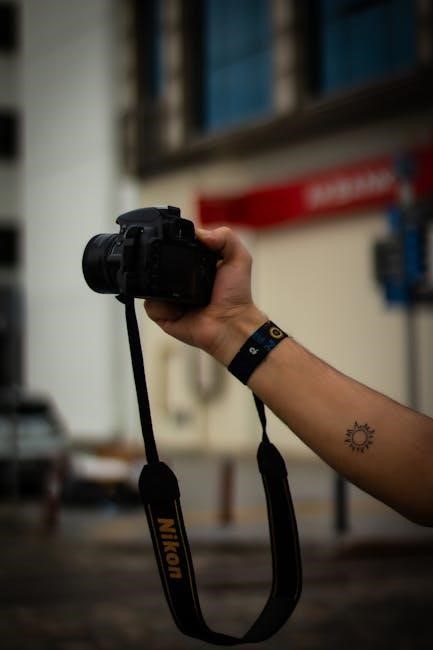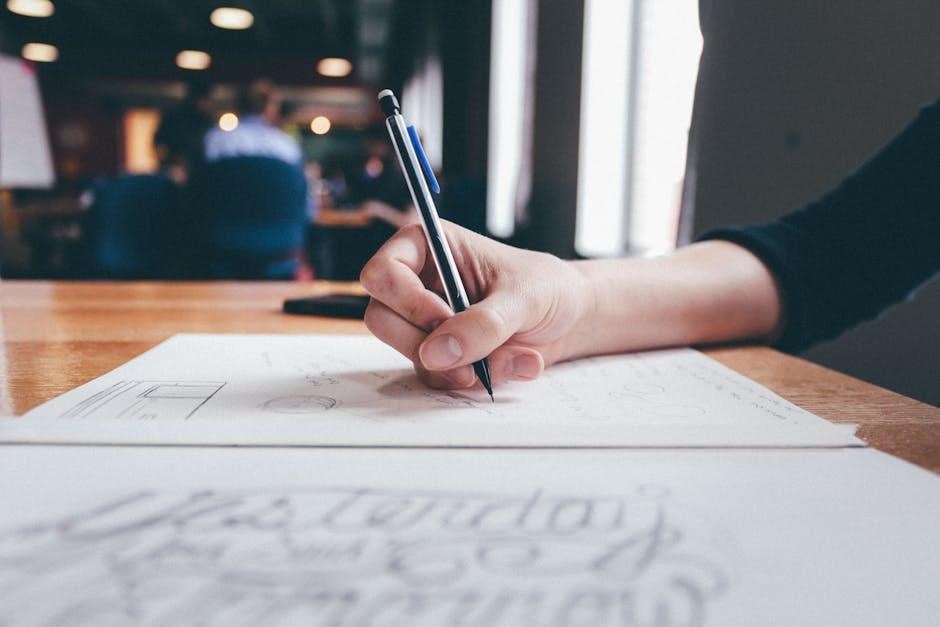The Nikon D5200 is an advanced DSLR camera designed for enthusiasts and professionals․ It features a 24․1MP APS-C sensor‚ EXPEED 3 processor‚ and vari-angle LCD screen․ This guide helps users master its functions and settings for optimal photography and video recording․
1․1 Overview of the Nikon D5200
The Nikon D5200 is a versatile and feature-rich DSLR camera designed for both enthusiasts and professionals․ It boasts a 24․1MP APS-C sensor‚ EXPEED 3 image processor‚ and a vari-angle 3-inch LCD screen for flexible shooting․ The camera supports Full HD video recording‚ built-in HDR‚ and a wide range of shooting modes‚ including PASM‚ scene‚ and effects modes․ Its ergonomic design and intuitive controls make it user-friendly‚ while its advanced features cater to creative photography needs․ The D5200 is accompanied by a comprehensive instruction manual‚ ensuring users can unlock its full potential․
1․2 Key Features of the Nikon D5200
The Nikon D5200 stands out with its 24․1MP APS-C sensor‚ delivering high-resolution images and excellent low-light performance․ It features the EXPEED 3 image processor‚ enabling fast operation and precise color reproduction․ The vari-angle 3-inch LCD screen offers flexibility for composing shots from various angles․ The camera supports Full HD 1080p video recording at 60i/50i‚ with built-in stereo microphone for clear audio․ Additionally‚ it includes 16 scene modes‚ HDR capabilities‚ and a range of special effects․ Its compatibility with Nikon’s F-mount lenses and accessories further enhances its versatility for both still photography and video capture․
1․3 Technical Specifications
The Nikon D5200 features a 24․1MP DX-format CMOS sensor and EXPEED 3 processor‚ ensuring sharp images and efficient performance․ Its ISO range extends from 100 to 6400‚ expandable to 25600 for low-light conditions․ The camera supports continuous shooting at 5 frames per second and records Full HD 1080p video at 60i/50i․ The 3-inch vari-angle LCD offers 921k-dot resolution‚ while the optical pentamirror viewfinder provides 95% frame coverage․ Wireless connectivity via optional WU-1a adapter enables image transfer and remote shooting․ The D5200 is compatible with Nikon’s F-mount lenses and accepts SD‚ SDHC‚ and SDXC memory cards․
1․4 Comparison with Other Nikon Models
The Nikon D5200 stands out among entry-level DSLRs‚ offering a 24․1MP sensor‚ surpassing the 16․2MP D5100․ It lacks the built-in GPS of the D5300 but matches its 39-point autofocus system․ Compared to the D7000‚ it has fewer weather-sealing features but is lighter and more affordable․ The D5200’s vari-angle screen and HD video capabilities make it a strong contender in Nikon’s lineup‚ balancing performance and price for enthusiasts and casual shooters alike․ Its features and portability position it well against other models in its class․

Setting Up the Camera
This section guides you through the initial setup process‚ including unpacking‚ battery installation‚ and basic camera configuration to ensure optimal performance right out of the box․
2․1 Unboxing and Initial Setup
Carefully unpack the Nikon D5200 from its box‚ ensuring all accessories are included․ Inspect the camera body for any damage or defects․ Gently remove the protective covering from the LCD screen․ Insert the provided EN-EL14 battery into the camera’s battery compartment‚ ensuring it clicks securely into place․ Install a memory card by sliding it into the card slot until it locks․ Familiarize yourself with the camera’s exterior‚ including the mode dial‚ buttons‚ and ports․ Refer to the manual for detailed setup instructions․ Charge the battery fully before first use․
2․2 Charging the Battery and Using Memory Cards
Charge the EN-EL14 battery using the provided MH-24 charger․ Connect the charger to a power source and ensure the battery is properly seated․ The charging indicator will turn off when complete‚ typically within 2 hours․ For memory cards‚ insert a compatible SD‚ SDHC‚ or SDXC card into the slot on the camera’s right side․ Use a card with sufficient storage for your needs‚ up to 64GB․ Format the card in the camera menu to ensure proper function․ Always format or erase cards in the camera‚ not on a computer‚ to avoid data loss․ Use high-speed cards for optimal performance․ Handle cards carefully to prevent damage․
2․3 Attaching Lenses and Accessories
To attach a lens‚ align the lens mount with the camera’s mount and rotate clockwise until it clicks․ Ensure the lens is securely locked to avoid damage․ For accessories like flashes or grips‚ use the hot shoe on top or the accessory terminal․ Always handle lenses with care to avoid scratching the glass or camera mirror․ Use the lens hood to reduce glare and protect the lens․ Store lenses with caps to prevent dust and damage․ Ensure all accessories are Nikon-compatible for proper functionality․
2․4 Updating Firmware
To update the Nikon D5200’s firmware‚ start by checking the current version in the camera menu under Setup > Firmware version․ Visit Nikon’s official website to download the latest firmware․ Transfer the update to a memory card using a card reader․ Insert the card into the camera‚ go to the Setup menu‚ and select Firmware update․ Follow on-screen instructions to complete the process․ Ensure the camera has a full battery and no memory cards are in use during the update․ Do not turn off the camera until the update is complete․

Understanding Camera Controls
Mastering the Nikon D5200’s controls is essential for optimal photography․ Familiarize yourself with the top plate‚ rear panel‚ and menu system for seamless operation and creative control․
3․1 Top Plate Controls
The top plate of the Nikon D5200 features essential controls for quick access during shooting․ The mode dial on the left allows selection of shooting modes‚ including Auto‚ PASM‚ Scene‚ and Effects․ On the right‚ the ISO button enables adjustments to sensitivity settings‚ while the exposure compensation button (+/-) fine-tunes brightness․ The shutter release button is centrally located‚ surrounded by the power switch․ Additional controls include the metering mode button and WB/Help buttons for white balance and metering options․ The LCD panel displays settings‚ and customizations can be made to suit individual preferences․ Mastering these controls enhances shooting efficiency and creativity․
3․2 Rear Panel Controls
The rear panel of the Nikon D5200 houses intuitive controls designed for efficient operation․ The Live View button activates video and still image preview‚ while the multi-selector navigates menus and selects focus points․ Surrounding it are buttons for AF lock‚ metering mode‚ and bracketing․ Playback and delete buttons manage image review․ The menu button accesses camera settings‚ and the zoom in/out buttons allow detailed image examination․ These controls streamline workflow‚ enabling quick adjustments and navigation during shooting sessions․ Proper use enhances both convenience and shooting efficiency․
3․3 Menu Navigation System
The Nikon D5200’s menu navigation system is user-friendly‚ allowing quick access to settings․ The multi-selector on the rear panel is used to scroll through menu items‚ while the OK button confirms selections․ The menu is divided into categories like Shooting‚ Setup‚ Retouch‚ and My Menu․ Each category contains relevant options for customization․ Users can navigate using the directional arrows and zoom buttons for efficient browsing․ The delete button returns to the previous menu‚ simplifying navigation․ This system ensures intuitive control over camera functions‚ making it easy to adjust settings on the fly․
Shooting Modes
The Nikon D5200 offers various shooting modes‚ including automatic‚ PASM (Program‚ Aperture‚ Shutter‚ Manual)‚ Scene‚ and Effects modes‚ catering to different photography needs and skill levels․
4․1 Automatic Modes
The Nikon D5200 features automatic shooting modes designed for ease of use‚ allowing the camera to handle most settings․ Auto Mode is ideal for beginners‚ automatically adjusting exposure‚ ISO‚ and focus․ Auto (Flash Off) disables the flash‚ useful in low-light conditions or where flash is prohibited․ These modes enable quick‚ hassle-free photography‚ letting you focus on composition while the camera manages technical details․ They are perfect for casual shooting or when you want to capture moments without adjusting settings manually․
4․2 Manual Modes (PASM)
The Nikon D5200 offers Programmed Auto (P)‚ Aperture Priority (A/Av)‚ Shutter Priority (S/Tv)‚ and Manual (M) modes‚ providing full creative control․ Programmed Auto allows flexibility while the camera adjusts settings․ Aperture Priority lets you set the aperture‚ controlling depth of field․ Shutter Priority enables you to set shutter speed for motion effects․ Manual Mode gives full control over aperture and shutter speed․ These modes are ideal for experienced photographers seeking precise control over exposure and artistic expression․
4․3 Scene Modes
The Nikon D5200 features a variety of Scene Modes designed to optimize camera settings for specific shooting situations․ Modes include Portrait‚ Landscape‚ Child‚ Sports‚ Close-up‚ Night Portrait‚ Party/Indoor‚ Beach/Snow‚ Sunset‚ Dusk/Dawn‚ Pet Portrait‚ Candlelight‚ Blossom‚ Autumn Colors‚ and Food․ Each mode adjusts exposure‚ ISO‚ and autofocus to capture the best possible image for the selected scenario‚ making it easy to achieve professional-looking results without manual adjustments․
4․4 Effects Modes
The Nikon D5200 offers a range of Effects Modes to enhance creativity in real-time․ Options include Night Vision‚ Color Sketch‚ Miniature Effect‚ Selective Color‚ Silhouette‚ High Key‚ and Low Key․ These modes apply unique visual effects to your images‚ such as infrared-like tones or toy-like perspectives․ They allow photographers to experiment with artistic styles without post-processing․ While fun to use‚ effects are best applied with intention‚ as they may not suit all subjects or lighting conditions․

Customizing Camera Settings
Customize your Nikon D5200 to suit your photography style․ Adjust settings like ISO‚ white balance‚ and autofocus to optimize performance․ Personalize controls for enhanced shooting efficiency․
5․1 ISO Sensitivity Settings
The Nikon D5200 allows you to adjust ISO sensitivity from 100 to 6400‚ with increments of 1/3 EV․ This range ensures flexibility in various lighting conditions․ Lower ISOs (100-400) are ideal for bright environments to minimize noise‚ while higher ISOs (800-6400) are suited for low-light situations․ The camera also features an Auto ISO mode‚ which automatically adjusts sensitivity based on lighting․ For precise control‚ you can set a maximum ISO limit in Auto mode to avoid excessive noise․ Experiment with ISO settings to balance image quality and low-light performance effectively․
5․2 White Balance Options
The Nikon D5200 offers various White Balance settings to ensure accurate color reproduction under different lighting conditions․ Options include Auto‚ Daylight‚ Shade‚ Tungsten‚ Fluorescent‚ Cloudy‚ and Custom․ Auto White Balance automatically adjusts based on the scene‚ while Daylight and Shade settings cater to natural light scenarios․ Tungsten and Fluorescent are ideal for indoor lighting‚ minimizing unwanted color casts․ Custom White Balance allows you to set a specific color temperature or use a reference object for precise calibration․ Adjusting White Balance is done through the Shooting Menu‚ enabling you to optimize image colors effectively in diverse environments․
5․3 Autofocus Configuration
The Nikon D5200 features a 39-point autofocus system‚ offering precise control over focus acquisition․ Users can configure autofocus modes‚ including AF-A (auto)‚ AF-C (continuous)‚ and AF-S (single-shot); The camera also supports 3D tracking for dynamic subjects․ Customization options include selecting AF points manually using the multi-selector or enabling auto-area AF for automatic subject detection․ The AF mode can be adjusted via the Shooting Menu‚ allowing photographers to tailor focus behavior to their shooting style and subject movement․ Proper configuration ensures sharp images in various scenarios․

Image Quality and Storage
The Nikon D5200 delivers high-quality images with its 24․1MP APS-C CMOS sensor‚ capturing vibrant colors and sharp details․ It supports SD‚ SDHC‚ and SDXC memory cards‚ including UHS-I for faster data transfer‚ ensuring efficient storage of high-resolution photos and videos․
6․1 Picture Control Options
The Nikon D5200 offers Picture Control options to refine image quality․ Settings like Standard‚ Neutral‚ Vivid‚ Monochrome‚ Portrait‚ and Landscape modify sharpening‚ contrast‚ brightness‚ saturation‚ and hue․ These adjustments allow customization to suit personal preferences or specific scenes․ Picture Controls apply to both JPEG and RAW files‚ with JPEGs reflecting the selected style directly‚ while RAW files store the settings as metadata for post-processing flexibility․ This feature enhances creativity by enabling photographers to achieve their desired aesthetic in-camera‚ ensuring consistent results across various shooting conditions․
6․2 RAW vs․ JPEG Format
The Nikon D5200 allows shooting in RAW (NEF) or JPEG formats․ RAW files store uncompressed data‚ offering maximum image detail and flexibility for post-processing․ JPEG files are processed in-camera‚ smaller in size‚ and ready for sharing․ RAW is ideal for professional editing‚ while JPEG suits everyday use․ The D5200 can record both formats simultaneously‚ providing a backup for editing and sharing․ Choose RAW for high-quality results and JPEG for convenience‚ depending on your workflow and storage needs․
6․3 Memory Card Management
The Nikon D5200 supports SD‚ SDHC‚ and SDXC memory cards‚ with UHS-I compatibility for faster data transfer․ Always use high-quality cards to ensure reliability․ Insert the card into the slot on the camera’s right side‚ and format it in the menu to optimize performance․ Avoid using cards formatted in other devices to prevent errors․ Store backups on multiple cards to safeguard your images․ Regularly clean and replace cards to maintain optimal camera functionality and prevent data loss during shoots․

Advanced Features
The Nikon D5200 offers advanced features like HDR‚ interval shooting‚ and time-lapse photography‚ enhancing creative possibilities․ These tools help capture stunning images and videos with ease․
7;1 HDR Photography
The Nikon D5200 supports HDR (High Dynamic Range) photography‚ combining multiple exposures to capture a wider dynamic range․ This feature is ideal for high-contrast scenes‚ such as landscapes or interiors with bright lighting and shadows․ To activate HDR‚ navigate to the Shooting Menu‚ select HDR‚ and choose from three modes: Auto‚ High‚ or Extra High․ The camera will take two exposures and merge them into one image with enhanced detail in both bright and dark areas․ Use a tripod for best results to avoid camera shake during the process․
7․2 Interval Shooting
Interval Shooting on the Nikon D5200 allows you to capture images at regular intervals‚ perfect for time-lapse photography․ To activate this feature‚ go to the Shooting Menu‚ select Interval Shooting‚ and set the interval‚ number of shots‚ and start time․ Use the multi-selector to adjust settings․ The camera will automatically capture images at the specified intervals․ For best results‚ use a tripod to prevent camera movement․ This feature is great for documenting events like sunrise‚ sunset‚ or cloud movements over time․
7․3 Time-Lapse Photography
Time-Lapse Photography on the Nikon D5200 allows you to create dynamic sequences by capturing images at set intervals and playing them back in rapid succession․ Access this feature via the Shooting Menu‚ where you can adjust settings like interval‚ total shots‚ and start time․ Use the multi-selector to navigate and confirm settings․ A tripod is essential for stability․ After shooting‚ the camera automatically creates a time-lapse movie․ This mode is ideal for capturing scenes like clouds moving‚ flowers blooming‚ or cityscapes․ Ensure ample memory card space and battery life before starting․

Video Recording
Activate Video Mode via the Mode dial and Live View button․ Capture full HD videos with frame rates up to 60fps․ Use a tripod for stability and external mic for better audio․
8․1 Basics of Video Mode
Activate Video Mode by rotating the Mode dial to the video position and pressing the Live View button; Set aperture‚ shutter speed‚ and ISO for manual control or use Auto mode․ Ensure the camera is stabilized‚ and focus is set before recording․ Adjust audio levels using the built-in microphone or connect an external mic for better sound quality․ Start and stop recording with the shutter release button․ Use the LCD screen to monitor your footage and ensure proper framing and lighting for optimal results․
8․2 Resolution and Frame Rates
The Nikon D5200 offers multiple video resolution options‚ including 1920×1080 (Full HD) and 1280×720 (HD)․ Frame rates range from 24p to 60p‚ allowing for cinematic or smooth motion effects․ For 1080p‚ choose 24p‚ 25p‚ 30p‚ 50p‚ or 60p‚ while 720p supports 50p or 60p․ Higher frame rates are ideal for fast-paced scenes‚ while lower rates create a more film-like look․ Use the menu system to adjust these settings‚ ensuring compatibility with your playback devices and creative vision․ Proper stabilization is recommended for higher frame rates to avoid shaky footage․
8․3 Essential Accessories for Video
For optimal video recording with the Nikon D5200‚ consider essential accessories․ An external microphone enhances audio quality‚ reducing wind noise and capturing clear sound․ A tripod or gimbal stabilizes the camera‚ preventing shaky footage․ Additional lighting‚ such as LED panels‚ improves video clarity in low-light conditions․ High-speed memory cards ensure smooth video recording without buffering․ Extra batteries and a battery grip extend shooting time․ These accessories elevate video production‚ enabling professional-grade results and enhancing creativity during filming sessions․

Autofocus System
The Nikon D5200 features a multi-CAM 4800DX autofocus sensor‚ offering 39 focus points for precise subject tracking․ It supports Single-shot AF‚ Continuous AF‚ and Manual focus modes․ The AF-assist lamp aids in low-light conditions‚ ensuring sharp focus acquisition․ Customizable AF settings allow users to tailor focus behavior to their shooting style‚ enhancing overall performance in various photography scenarios․
9․1 How Autofocus Works
The Nikon D5200’s autofocus system uses a multi-CAM 4800DX sensor with 39 focus points to detect and track subjects․ It employs phase-detection AF‚ calculating distance by comparing light from different angles․ The camera automatically selects focus points based on subject placement or allows manual point selection․ The AF-assist lamp aids in low-light conditions by projecting a red pattern․ The system continuously adjusts focus in Continuous AF mode‚ ensuring sharp images even with moving subjects․ This advanced technology enhances accuracy and speed‚ making it ideal for various photography scenarios․
9․2 Autofocus Modes
The Nikon D5200 offers four autofocus modes: AF-S‚ AF-C‚ AF-A‚ and MF․ AF-S (Single AF) is ideal for stationary subjects‚ focusing once and locking․ AF-C (Continuous AF) tracks moving subjects‚ adjusting focus continuously․ AF-A automatically switches between AF-S and AF-C based on subject movement․ MF (Manual Focus) allows precise focus adjustment using the lens ring․ These modes can be selected via the camera’s control panel or menu‚ ensuring flexibility for various shooting scenarios․ The D5200 also supports manual focus point selection or automatic selection from 39 focus points․
9․3 Customizing Autofocus Settings
The Nikon D5200 allows users to customize autofocus settings for enhanced performance․ Through the menu system‚ you can adjust AF point selection‚ focus tracking‚ and dynamic area AF․ The camera offers options like 39 focus points and 3D tracking‚ which can be tailored to suit different subjects and shooting styles․ Customizing these settings improves autofocus accuracy and speed‚ ensuring sharper images in various conditions․ These adjustments can be made via the AF customization menu‚ providing flexibility for photographers to adapt to their creative needs․

Maintenance and Troubleshooting
Regular maintenance ensures optimal performance․ Clean the sensor‚ check firmware updates‚ and troubleshoot common issues like error messages or shutter malfunctions to prevent damage and ensure reliability․
10․1 Cleaning the Camera Sensor
Cleaning the camera sensor is crucial for maintaining image quality․ Turn off the camera‚ ensure the battery is fully charged‚ and access the sensor by pressing the OK button․ Use a hand blower to gently remove dust and debris․ Avoid touching the sensor surface to prevent damage․ For stubborn spots‚ use Nikon-approved cleaning tools like a swab or brush․ Always clean in a dust-free environment and refer to the manual for detailed steps to ensure safety and effectiveness․
10․2 Updating Firmware
To update the Nikon D5200 firmware‚ first check the current version in the camera menu under Setup Menu > Firmware Version․ Visit Nikon’s official website to download the latest firmware․ Use a fully charged battery and a formatted memory card for the update․ Copy the firmware file to the card’s root directory‚ insert it into the camera‚ and follow on-screen instructions․ Ensure the camera is not turned off during the process․ Updating firmware enhances performance‚ fixes bugs‚ and adds new features to your camera․
10․3 Common Issues and Solutions
Common issues with the Nikon D5200 include error messages‚ poor image quality‚ or memory card errors․ For error messages‚ restart the camera or reset settings to default․ If images appear blurry‚ check autofocus settings or clean the sensor․ Memory card errors may require formatting the card in the camera․ For persistent autofocus issues‚ ensure the lens is clean and properly attached․ If problems persist‚ refer to the manual or contact Nikon support for assistance․
- Restart the camera to resolve temporary glitches․
- Check ISO and autofocus settings for optimal image quality․
- Format memory cards in the camera to avoid errors․

Additional Resources
Explore official Nikon resources for enhanced learning and troubleshooting․ Utilize the Nikon D5200 manual‚ Manual Viewer app‚ online forums‚ and authorized service centers for comprehensive support․
- Nikon D5200 Manual PDF for detailed instructions․
- Manual Viewer app for on-the-go guidance․
- Online forums for user discussions and tips․
- Authorized service centers for professional assistance․
11․1 Nikon D5200 Manual PDF
The Nikon D5200 Manual PDF is an essential resource for mastering your camera․ It provides detailed instructions on all features‚ settings‚ and functions․ Available for free download from Nikon’s official website‚ the manual covers everything from basic operations to advanced techniques․ It includes troubleshooting guides‚ technical specifications‚ and tips for improving your photography․ The PDF format makes it easy to access on computers‚ tablets‚ or smartphones‚ ensuring you always have a reference handy․ Regularly updated‚ it remains a comprehensive guide for both beginners and experienced users․
- Downloadable from Nikon’s official website․
- Covers all camera features and settings․
- Includes troubleshooting and technical details․
- Compatible with multiple devices for easy access․
11․2 Nikon Manual Viewer App
The Nikon Manual Viewer App is a convenient digital platform for accessing the Nikon D5200 instruction manual․ Designed for smartphones and tablets‚ it provides an interactive and searchable version of the manual․ Users can easily navigate through sections‚ bookmark important pages‚ and access tutorials․ Available for both iOS and Android‚ the app offers offline access‚ making it ideal for on-the-go reference․ Its intuitive interface ensures quick access to information‚ helping photographers of all levels master their camera․ Regular updates keep the content current and relevant․
- Interactive and searchable manual․
- Available for iOS and Android․
- Offline access for convenience․
- Bookmarking and tutorial features․
11․3 Online Communities and Forums
Online communities and forums dedicated to the Nikon D5200 are invaluable resources for photographers․ Platforms like Nikon’s official forums‚ Reddit‚ and Facebook groups offer spaces to discuss techniques‚ troubleshoot issues‚ and share experiences․ These communities are rich with user-generated content‚ including tips‚ tutorials‚ and real-world insights․ Engaging with fellow photographers can enhance your understanding of the camera and inspire new creative approaches․ Additionally‚ many forums host expert Q&A sessions and provide access to downloadable resources․
- Share knowledge and techniques with photographers․
- Troubleshoot common issues and errors․
- Access user-generated tips and tutorials․
- Participate in Q&A sessions with experts․
11․4 Authorized Service Centers
Authorized Nikon service centers provide professional repair and maintenance services for the D5200․ These centers are certified by Nikon‚ ensuring genuine parts and expert technicians․ For warranty repairs‚ calibration‚ or general maintenance‚ visit an authorized center․ Use Nikon’s official website to locate the nearest service center and ensure your camera receives high-quality care․ Regular maintenance helps maintain optimal performance and extends the camera’s lifespan․
- Certified by Nikon for reliable service․
- Use genuine parts and expert technicians․
- Essential for warranty repairs and maintenance․
- Find centers via Nikon’s official website․